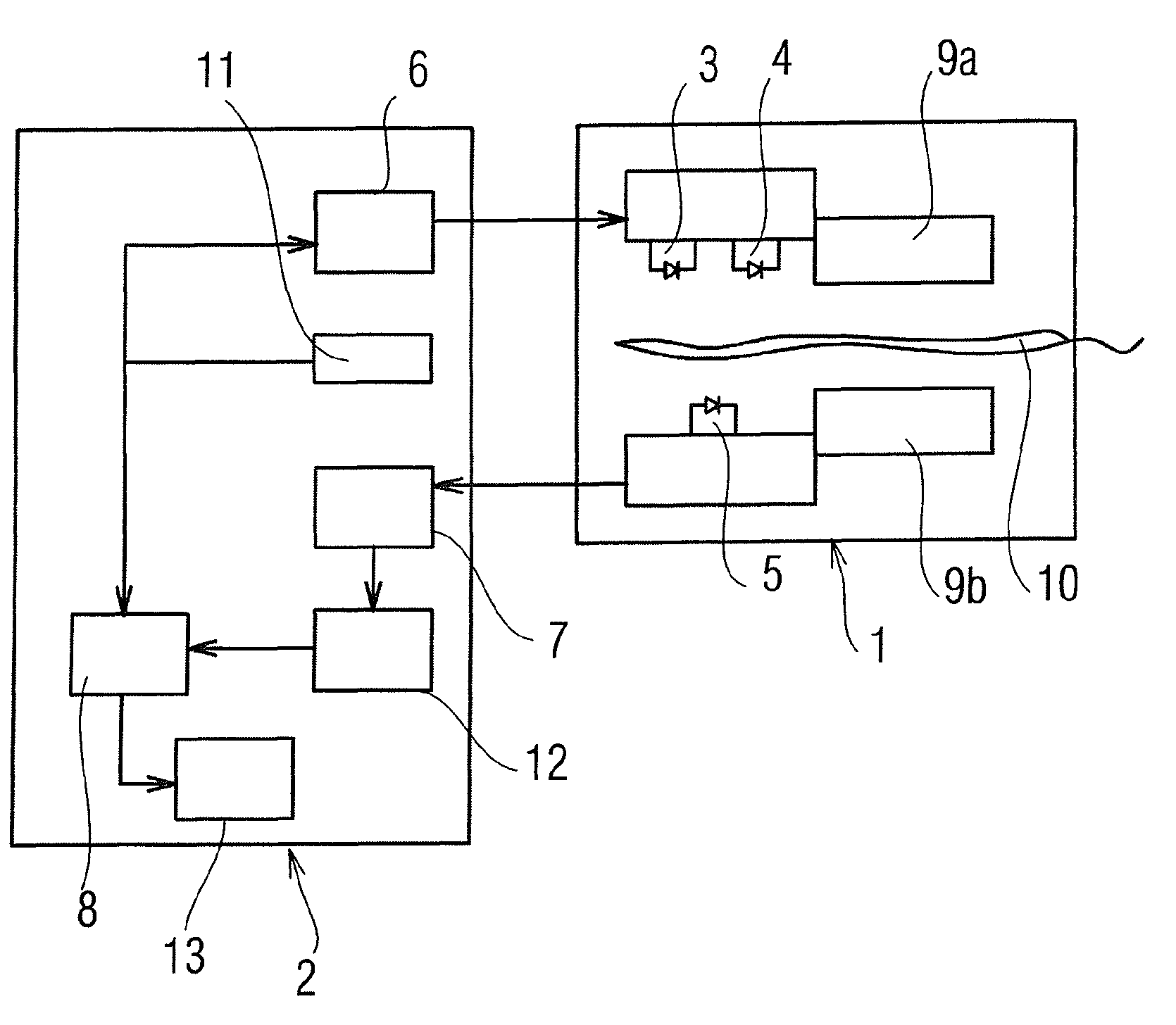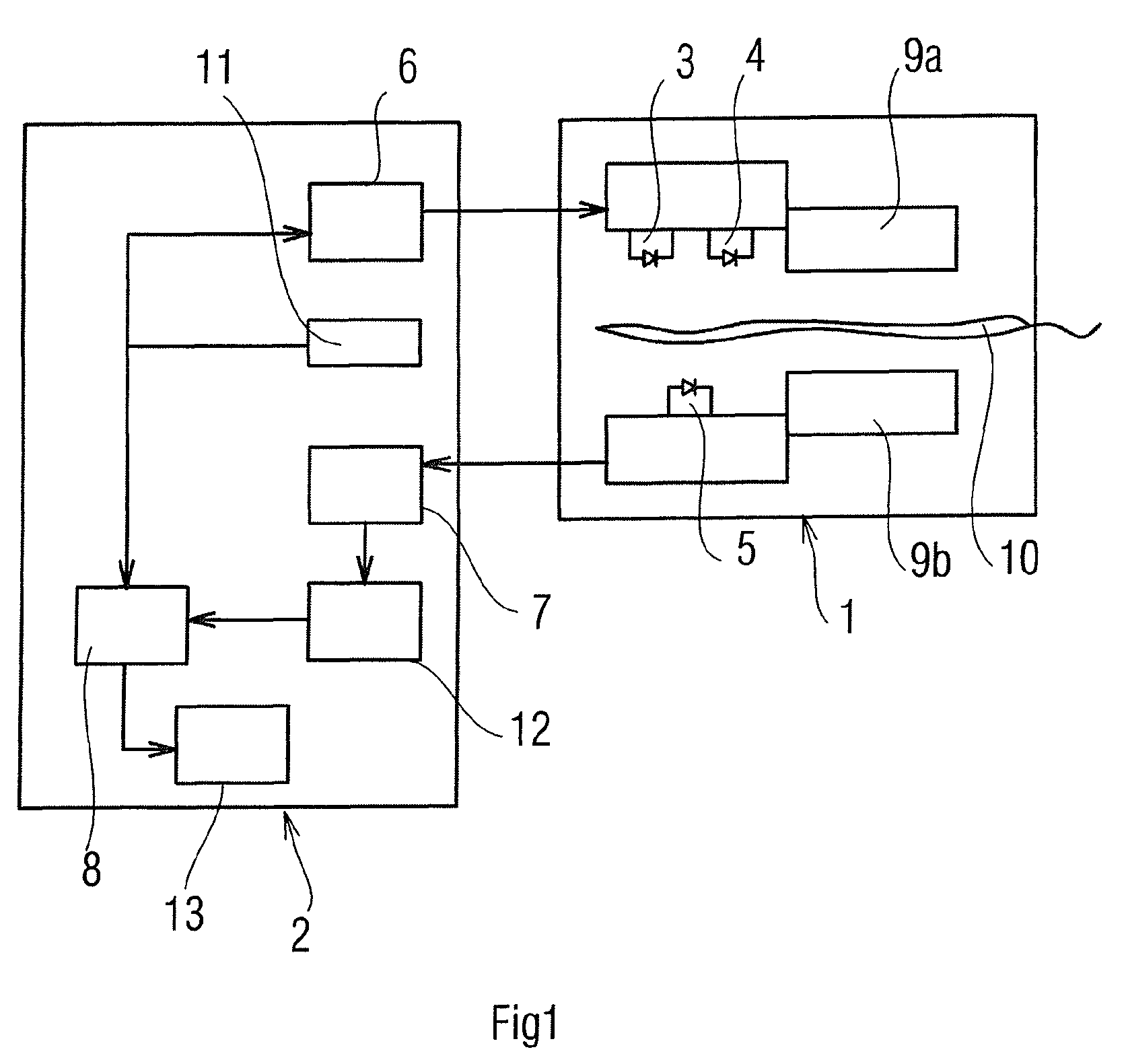Device for optoelectronic measurement of the hydration of a plant in its natural environment
a technology of hydration and optoelectronic measurement, which is applied in the field of evaluation and tracking of the state of hydration of plant covers, can solve the problems of not providing the the types of soil and the contour, and the inability to provide critical points that make it possible to take into account the nature of plants, etc., and is not suitable for the production of terrain measurements
- Summary
- Abstract
- Description
- Claims
- Application Information
AI Technical Summary
Benefits of technology
Problems solved by technology
Method used
Image
Examples
example 1
Device for Photometric Measurement of a Plant Element
[0077]The device for determining the hydration rate of a plant element in its natural environment comprises here the optoelectronic probe 1, combined with the measuring box 2. The probe 1 comprises two LEDs that emit a narrow-band spectrum: LED 3 that emits at the wavelength of 1,940 nm that corresponds to a band of high water absorption, as well as LED 4, emitting at 1,300 nm and slightly absorbed by water. It also comprises the photodiode 5 that is coupled to its amplifier, whose spectral response corresponds to the emission bands of the two LEDs. The box 2 contains a primary electronic card that integrates the bulk of the electronics implemented. The box 2 and the probe 1 form two separate elements that are connected physically by a cable or a ribbon cable. The adjustment of the central emission wavelength of LED 3 is carried out by the temperature regulator 9a of the junction. LED 4 that is centered on 1,300 nm makes possible ...
example 2
Device with a Moving Element Supporting the Probe
[0084]In FIG. 3, the probe 1 of the device that is described in Example 1 is carried by the moving element 20, comprises the two jaws 21 and 22 that move around the joint 24 and are separated by the gap 23. This element makes it possible:[0085]To collect the detection electronics of the photometer;[0086]To ensure the positioning and the holding of LEDs 3 and 4 and of the photodiode 5 in the measurement configuration;[0087]To ensure, by a suitable ergonomy, the production and the repetition of transmittance measurements in vivo on plant samples.
[0088]The implementation of the moving element 20 (opening / closing) can be carried out automatically or manually. The neutral position of the jaws 21, 22 is ensured by the action of springs 28 and varies according to the automatic or manual mode. In automatic mode, the neutral position is the closed position that is maintained by draw springs; in manual mode, the neutral position is the open pos...
example 3
Apparatus for Tracking the State of Hydration of a Plant Cover
[0090]The apparatus that is shown in FIG. 2 is produced with a device and a moving element as described in Examples 1 and 2 respectively. The apparatus that is presented here has an automatic operating mode. It comprises means for holding the plant sample in a non-restrictive position, and communication means 31 with a control module 30, connected by the cabling 26.
3.1) Holding the Sample
[0091]The portico 27 consists of a circular rod with variable geometry according to the morphology of the sample (leaf surface, length / width ratio, . . . ) and of the plant that carries it (woody or non-woody plant). It has a standard ending, for example two parallel pins, making possible its insertion into the body of the apparatus. Fastening straps that make it possible to attach the plant in a way that does not alter or destroy it consist of:[0092]One or two points for fastening to the portico, adjustable in position by sliding and imm...
PUM
 Login to View More
Login to View More Abstract
Description
Claims
Application Information
 Login to View More
Login to View More - R&D
- Intellectual Property
- Life Sciences
- Materials
- Tech Scout
- Unparalleled Data Quality
- Higher Quality Content
- 60% Fewer Hallucinations
Browse by: Latest US Patents, China's latest patents, Technical Efficacy Thesaurus, Application Domain, Technology Topic, Popular Technical Reports.
© 2025 PatSnap. All rights reserved.Legal|Privacy policy|Modern Slavery Act Transparency Statement|Sitemap|About US| Contact US: help@patsnap.com



